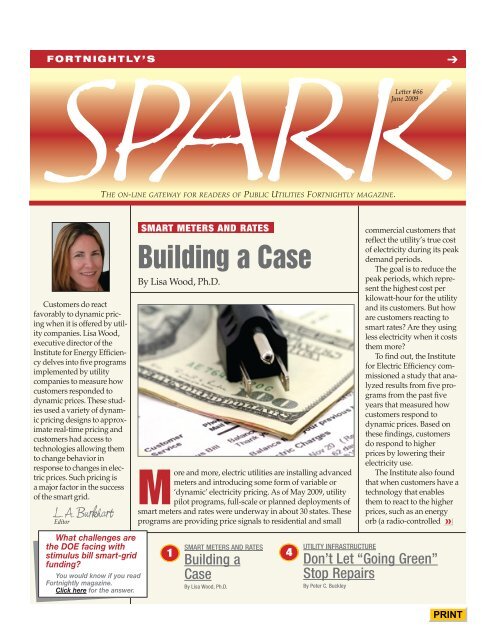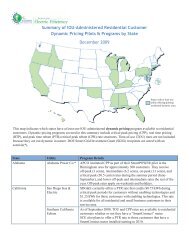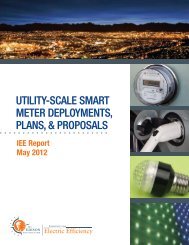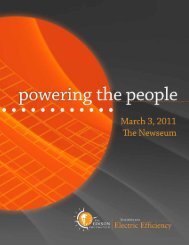Smart Meters and Rates: Building a Case - Edison Foundation
Smart Meters and Rates: Building a Case - Edison Foundation
Smart Meters and Rates: Building a Case - Edison Foundation
Create successful ePaper yourself
Turn your PDF publications into a flip-book with our unique Google optimized e-Paper software.
FORTNIGHTLY’SSSPARKLetter #??? #66June April 2009 2007THEThe ON-LINE on-line GATEWAY gateway FOR for READERS readers OF of Public PUBLICUtilities UTILITIESFortnightly FORTNIGHTLY magazine. MAGAZINE.➔Customers do reactfavorably to dynamic pricingwhen it is offered by utilitycompanies. Lisa Wood,executive director of theInstitute for Energy Efficiencydelves into five programsimplemented by utilitycompanies to measure howcustomers responded todynamic prices. These studiesused a variety of dynamicpricing designs to approximatereal-time pricing <strong>and</strong>customers had access totechnologies allowing themto change behavior inresponse to changes in electricprices. Such pricing isa major factor in the successof the smart grid.L. A. BurkhartEditorWhat challenges arethe DOE facing withstimulus bill smart-gridfunding?You would know if you readFortnightly magazine.Click here for the answer.SMART METERS AND RATES<strong>Building</strong> a <strong>Case</strong>By Lisa Wood, Ph.D.More <strong>and</strong> more, electric utilities are installing advancedmeters <strong>and</strong> introducing some form of variable or‘dynamic’ electricity pricing. As of May 2009, utilitypilot programs, full-scale or planned deployments ofsmart meters <strong>and</strong> rates were underway in about 30 states. Theseprograms are providing price signals to residential <strong>and</strong> small1SMART METERS AND RATES<strong>Building</strong> a<strong>Case</strong>By Lisa Wood, Ph.D.4commercial customers thatreflect the utility’s true costof electricity during its peakdem<strong>and</strong> periods.The goal is to reduce thepeak periods, which representthe highest cost perkilowatt-hour for the utility<strong>and</strong> its customers. But howare customers reacting tosmart rates? Are they usingless electricity when it coststhem more?To find out, the Institutefor Electric Efficiency commissioneda study that analyzedresults from five programsfrom the past fiveyears that measured howcustomers respond todynamic prices. Based onthese findings, customersdo respond to higherprices by lowering theirelectricity use.The Institute also foundthat when customers have atechnology that enablesthem to react to the higherprices, such as an energyorb (a radio-controlledUTILITY INFRASTRUCTUREDon’t Let “Going Green”Stop RepairsBy Peter C. Buckley»
➔SPARK➔device in the shape of a ball thatchanges color in response to the priceof electricity) or a thermostat that automaticallycontrols an air conditioner’ssettings based on the price of power,customers respond even more to ahigh-price signal.The programs studied:1. California’s Statewide PricingPilot Program—2003-2004;2. Baltimore Gas <strong>and</strong> ElectricCompany <strong>Smart</strong> Energy PricingPilot—2008;3. Public Service Electric <strong>and</strong> GasCompany MyPower Pricing PilotProgram—2007;4. Commonwealth <strong>Edison</strong>’sCommunity Energy Cooperative’sEnergy <strong>Smart</strong> Pricing Plan—Full-scale rollout; <strong>and</strong>5. Pacific Gas <strong>and</strong> ElectricCompany’s <strong>Smart</strong>Rate Program—Full-scale roll-out.These programs were chosenbecause of their strong adherence tosound experimental design <strong>and</strong> statisticalanalysis principles. Consequently,these results can be generalized to thelarger population of customers in theUnited States. The Brattle Group,which conducted the study, also foundthat the findings were supported byseveral other pilot programs that Brattleexamined in North America, Europe,<strong>and</strong> Australia over the last 15 years.Dynamic PricingEach of the five programs studiedused a variety of dynamic pricingdesigns to approximate real-time pricing(RTP), where customers pay electricityprices that are linked to thewholesale cost of electricity on anhourly (or sub-hourly) basis. The programsalso used a mixture of enablingtechnologies to help customers reactto the changing prices.Although RTP may be ideal froma price signal perspective, for mostsmaller mass-market customers (e.g.,residential <strong>and</strong> small commercial) itusually is not a practical option. For themajority of these customers, approximationsof RTP make more sense.Time-of-use (TOU) rates, whichhave been in existence for over 30years, attempt to reflect the differentcosts of providing electricity duringpeak <strong>and</strong> off-peak periods. But TOUrates are not dynamic in that they doCustomers could be given real-timein-home displays that break up their poweruse by hour, <strong>and</strong> tells them how much theyare paying during the critical peak hours.not change based on actual wholesalemarket prices.Some of the utilities in the studyused a critical peak pricing (CPP) programto accurately reflect the true costof electricity during their extra-highcost hours — between 60 <strong>and</strong> 100 hoursper year.Under a CPP mechanism, a peak<strong>and</strong> an off-peak rate were set, withthe peak rate being higher than theoff-peak rate. When a critical peakoccured, the peak rate would increase.Customers could save money by loweringtheir electricity use during theCPP periods.Utilities in the study also used apeak-time rebate (PTR) rate. A PTRrate is a mirror image of the CPP rate.Under the PTR program, instead ofpaying higher rates during the criticalpeak hours, customers would receive acash rebate for each kiloWatt-hour ofelectricity they did not use during thecritical peak hours.One advantage of the PTR rate wasthat if customers did not respond—»FORTNIGHTLY’SSPARKCopyright 2009Public Utilities Reports, Inc.8229 Boone Blvd., Suite 400Vienna, VA 22182Phone: 703–847–7720800–368–5001Fax: 703–847–0683http://www.pur.comBruce Radford, Publisherradford@pur.comLori A. Burkhart, Editorlab@pur.comHoria Stefanescu, Designerahstephen@pur.comE-mailed to allFortnightly subscribers.Call: 800–368–5001For e–mail address changesor other information, contactjcole@pur.com or 800–368–5001.Except for one copy to the subscriber, reproduction is not to be made in whole or in part without special permission.Page 2 June 2009
➔SPARK➔meaning if they did not lower theirelectricity use during the critical peakperiod—their bills would remain thesame. In other words, the PTR rateoffered bill protection in that customersdid not pay more than what theyalready were paying for electricity.Based on the study’s findings, thefollowing steps are recommended tointroduce dynamic pricing to residential<strong>and</strong> small-commercial customers:Create customer buy in—Customersneed to be educated about whyrates change <strong>and</strong> why lowering theirelectricity use during peak periodshelps them, their utility, <strong>and</strong> the environment.Offer tools such as in home displays—Allcustomers should be givenbasic information on how much of theirutility bill comes from various end-usessuch as lighting, laundry <strong>and</strong> air conditioning,<strong>and</strong> what actions will have thelargest impact on their bills. At the nextlevel, customers could be given realtimein-home displays that break uptheir power use by hour, <strong>and</strong> tells themhow much they are paying during thecritical peak hours. Finally, all customersshould be given enabling technologies,such as energy orbs or programmablecommunicating thermostats,to help them better manage theirelectricity use during the critical hours.Give customers choices—Dynamicpricing rates, even with all the itemsmentioned above, may not be appropriatefor some customers. And fixedrates may not be appropriate for othercustomers. All customers should havethe option of migrating to differenttypes of time-varying rates (perhapswith varying lengths of the peak period<strong>and</strong> with varying numbers of pricingperiods) or between time-varying <strong>and</strong>fixed rates.AMI Costs <strong>and</strong> BenefitsEvery utility considering smartmeters <strong>and</strong> smart rates will need topresent a business case for the investment.Advanced metering infrastructure(AMI), which creates the two-waycommunication capabilities (betweenthe utility <strong>and</strong> the customer) necessaryfor smart rates to be introduced, representsa significant cost for utilities. Thecosts include the system hardware (primarilymeter) <strong>and</strong> software, the laborto install the new meters, customereducation, <strong>and</strong> IT system integrationcosts.To identify the relative benefits ofinvesting in AMI, the study looked attwo utilities, Pacific Gas & Electric <strong>and</strong>Southern California <strong>Edison</strong>, whichhave begun deploying AMI throughouttheir service areas. Through theseutilities’ experiences, a number of benefitswere identified, which can begrouped into three categories—customerbenefits, operational benefits,<strong>and</strong> price responsive dem<strong>and</strong> benefits.Customer benefits include moreaccurate <strong>and</strong> prompt billing, faster resolutionof the disputed bills, <strong>and</strong> betterelectricity service due to faster detection<strong>and</strong> response to power outages.All customers should have the optionof migrating to different types of timevaryingrates or between time-varying<strong>and</strong> fixed rates.The major operational benefit ofAMI is the elimination of manual meterreading. When automated readingreplaces the traditional manual reading,all the variable costs of manualreading are avoided. This benefit typicallyrepresents one-third to two-thirdsof the total utility operational benefitsof AMI.The price-responsive dem<strong>and</strong> benefitsof AMI include the lower capital<strong>and</strong> energy costs that result fromreducing peak dem<strong>and</strong> periods.Customers are responsive todynamic pricing, <strong>and</strong> the technology todeliver it is increasingly within reach,as AMI, in-home displays, home areanetworks, <strong>and</strong> other smart-grid technologiesbecome more widespreadthroughout the nation. With this study,the Institute for Electric Efficiencyhopes that more service areas nowwill have the confidence to put theminto use. ■Lisa Wood, Ph.D. is Executive Director atthe Institute for Electric Efficiency. Website: www.edisonfoundation.net/iee.Complete details about the study, “MovingToward Utility-Scale Deployment ofDynamic Pricing in Mass Markets,” areavailable at www.edisonfoundation.net/iee/.Page 3June 2009
➔SPARK➔UTILITY INFRASTRUCTUREDon’t Let “Going Green”Stop RepairsBy Peter C. BuckleyThe American Reinvestment <strong>and</strong>Recovery Act is providing billionsof dollars to improve ournation’s infrastructure; however,with so many deserving projects vyingfor funding, there is often a choicebetween repairing our decaying infrastructure<strong>and</strong> making it “greener”through the implementation of newtechnologies. As demonstrated by therecent wave of “green” advertising,“going green” is the more popularchoice for decision makers looking toappeal to public opinion. A recent $6million dollar personal injury settlementin New Jersey arising from acity’s repeated failure to replace a brokenunderground lateral provides,however, an expensive reminder of thecost of neglecting necessary repairs toexisting infrastructure.The City of Newark, New Jerseyrecently reached such an expensive settlementwith a plaintiff who sufferedlife-altering injuries to her back aftershe fell on a section of roadway thathad been repeatedly undermined by aPage 4damaged underground pipe. Theplaintiff developed evidence that anunderground lateral attached to asewer basin had repeatedly caused theroad above to collapse, <strong>and</strong> that —rather than replacing the pipe — theCity’s road department continued toprovide only a temporary “fix,” coveringthe area with a metal plate <strong>and</strong> acold patch. Through depositions ofCity employees, she was able touncover an apparent dispute betweenthe City’s road department <strong>and</strong> theCity’s sewer department over responsibilityfor the permanent repair. Whilethe two departments debated overresponsibility, the plaintiff alleged, theunderground pipe repeatedly caused adangerous depression in the roadwayabove. The plaintiff alleged that she fellwhile exiting her car as a result of thedangerous depression caused by thetemporary “fix” <strong>and</strong> exacerbated bythe departmental infighting. The $6million dollar settlement is indicativeof the nature of her back injury, whicheventually required surgery <strong>and</strong> theFaced with competing priorities, conflictingjurisdiction, or limited resources,utility companies often employ a temporary“fix” rather than a permanent repair.implantation of a morphine pump tomanage her constant pain.While the amount of the Newarksettlement certainly is not typical of“slip <strong>and</strong> fall” litigation, these very circumstancesare all too common in tortlitigation involving utility companies.Faced with competing priorities, conflictingjurisdiction, or limitedresources, utility companies oftenemploy a temporary “fix” rather than apermanent repair. It is this patchworkof temporary “fixes” that is responsible— at least in part — for our nation’sdecaying infrastructure.Most states maintain some form ofgovernmental immunity, allowing aclaim to proceed against a municipalutility only in certain limited circumstances.In New Jersey <strong>and</strong> Pennsylvania(the two states with which I am mostfamiliar), the municipal utility must beon notice of the dangerous conditionassociated with its utility service facilitiesat a sufficient time in advance of theinjury to have taken measures to protectagainst it for liability to be imposed. Inthe case of Newark, the repeated temporaryrepairs to the pipe <strong>and</strong> theinfighting over responsibility providedthe requisite notice <strong>and</strong> aided the plaintiffin obtaining a favorable settlement.Though laws vary state-to-state, privately-ownedutilities are often notafforded this additional level of protection,exposing them to tort liability»June 2009
➔SPARK➔even where prior notice does not exist.Undoubtedly, every utility has a listof temporary “fixes” that are maintainedlonger than anticipated in orderto allow the implementation of a newproject — no one gets promoted orelected on a platform of “shoring up”existing infrastructure; it is the new <strong>and</strong>ever “greener” projects that garner theNew Orleans City CouncilRequest for ProposalsExecutive Search ServicesThe City Council of New Orleans, Louisiana, exercises primary regulatory jurisdiction overthe provision of electric <strong>and</strong> natural gas services in the city <strong>and</strong> administers the franchises<strong>and</strong> permits of electric, natural gas, thermal energy, cable <strong>and</strong> telecommunications providersin Orleans Parish. The City Council wishes to retain the services of a nationally recognizedexecutive search firm to identify <strong>and</strong> recruit qualified c<strong>and</strong>idates for its recently vacatedposition of Director of City Council Utilities Regulatory Office. The Council is seeking proposalsfrom qualified executive search firms with demonstrated successes <strong>and</strong> extensive background<strong>and</strong> experience in performing executive search recruiting services in the regulatedutilities industry with in depth experience in the placement of individuals with regulatoryexperience. The Council’s complete Request for Proposals is available on the Council’swebsite, www.nocitycouncil.com/rfps.asp or may be obtained from the office of the CouncilChief of Staff, Room 1E06, City Hall, 1300 Perdido Street, New Orleans, Louisiana, 70112(504) 658-1082, e-mail rjpursell@cityofno.com. Proposals must be received by 3:00 p.m.,Friday, August 7, 2009.headlines. While the potential for tortliability provides only one considerationin deciding where to spend thestimulus dollars, examples like the $6million settlement in Newark demonstratethat there is a potential cost —both in terms of public safety <strong>and</strong> thebottom line — to neglecting permanentrepairs to existing infrastructure. ■Peter Buckley is an attorney in the PhiladelphiaOffice of Fox Rothschild LLP <strong>and</strong> amember of the firm’s Infrastructure PracticeGroup. His practice includes the defenseof utility companies in tort litigation – inparticular, municipal utilities <strong>and</strong> thedefense of governmental immunity.As a three-year summer laborer at his hometownwater department during college, Peterinstalled fire hydrants, water mains, <strong>and</strong> gatevalves – gaining an intimate knowledge of the“front lines” of the utility industry. Peter canbe reached at 215-299-2854 or pcbuckley@foxrothschild.com.PUR GUIDEAvailablenowAvailablenowGoing Green<strong>and</strong> GettingRegulation Right:A Primer forEnergy EfficiencyBy Charles J. Cicchetti, Ph.D.»Page 5 June 2009
➔SPARK➔Next Month’sFORTNIGHTLYThe July issue of Fortnightly magazine takes an in-depth look at what is entailed in buildinga true electric smart grid, <strong>and</strong> how to secure it. In “A Voice for <strong>Smart</strong>-Grid Security,”Darren Reece Highfill <strong>and</strong> Vishant Shah investigate who will oversee the industry’s cyberst<strong>and</strong>ards? They argue that effective security calls for a single organization to set st<strong>and</strong>ardsthat will protect the smart grid. The industry is struggling to reach consensus over authority,scope <strong>and</strong> funding for its new security apparatus.Here is more of what you will find: Fingerprinting the Invisible H<strong>and</strong>sSecrecy is the norm in electric power bidding. This lack of transparency impedes an efficientelectricity market. Bringing daylight to power markets would reduce prices <strong>and</strong> saveconsumers money. <strong>Smart</strong>-Grid Strategy: Quantifying BenefitsAs utilities announce new smart-grid programs, they need a strategic method for quantifyingbenefits. Analytical models generate baseline benefit estimates <strong>and</strong> reveal big-picturetrends. Decision makers need the best resources available to mitigate risks in choosinga smart-grid strategy. Life After PUHCAWhen Congress repealed the Holding Company Act, it gave states greater authority toregulate utilities. New Jersey picked up the baton <strong>and</strong> enacted rules to protect ratepayers. Ontario’s Failed Experiment (Part 1 of 2 parts)After 10 years of incentive regulation, reliability has declined in Ontario. Regulatorsfailed to enforce service-quality st<strong>and</strong>ards, <strong>and</strong> consumers are suffering as a result.TO ADVERTISE INSPARKCLICKHEREOR CALL703-847-7759Page 6June 2009











